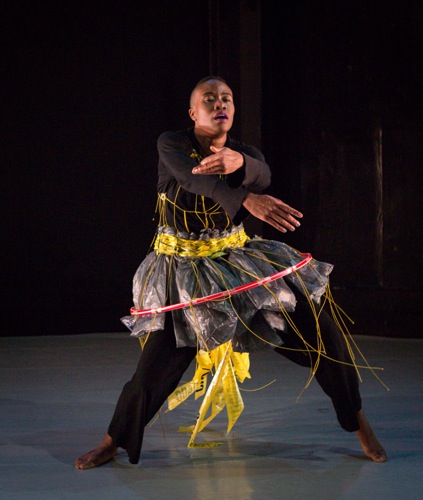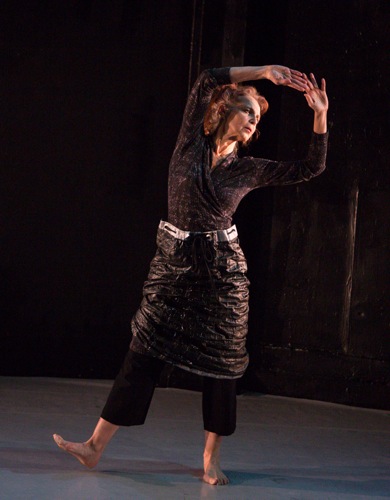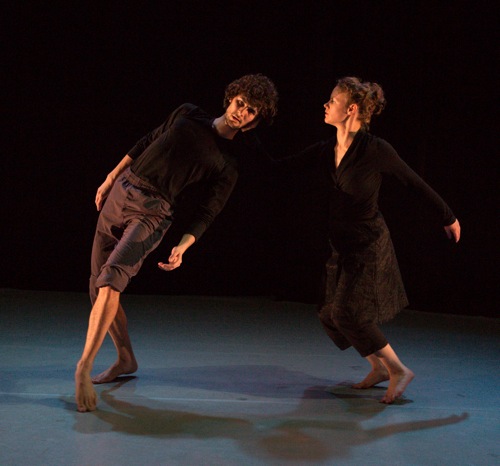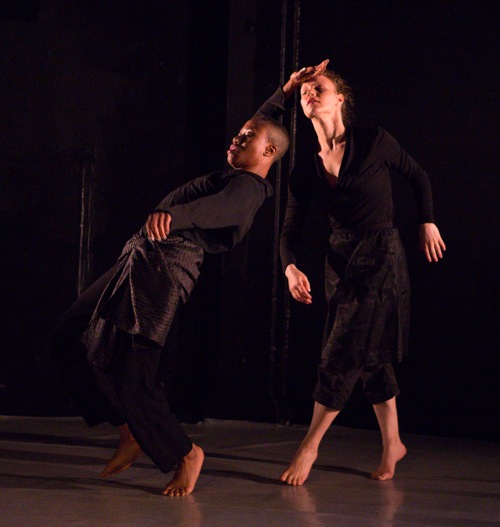Vicky Shick and colleagues premiere a new work.
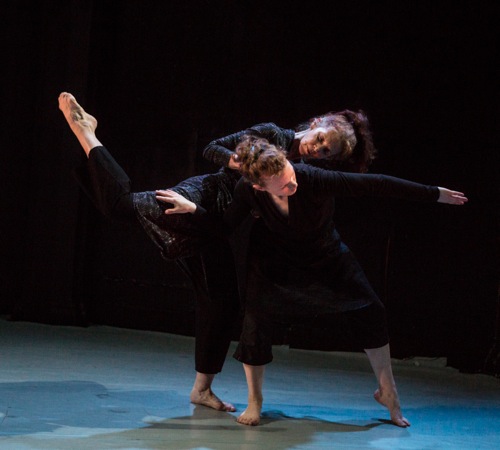
Vicky Shick (rear) and Marilyn Maywald in Shick’s Pathétique/Miniatures in Detail. Photo: Yi-Chun Wu
The second week of April, 2014, both the Trisha Brown Dance Company and the Stephen Petronio Company performed in New York. The following week, and further uptown, Vicky Shick premiered her Pathétique/Miniatures in Detail. An enlivening coincidence. Shick, like Petronio, performed in Brown’s company for a number of years—in her case from 1980-1986. If he subsequently pushed into the wilder thickets of Brown’s intricate movement ideas and created his own fierce, seductive style, Shick investigated the softer aspects of Brownian choreography—pitting small gestures and everyday encounters against bigger, juicier motion.
Of the three seasons, hers took place in the smallest theater, as part of the second 2014 installment of Soaking Wet, a series produced by David Parker and Jeffrey Kazin of the Bang Group. To see Pathétique/Miniatures in Detail, you walk up a ramp into the Church of St. Paul & St. Anthony on West 86th Street, climb to the second floor, and enter the West End Theater, which turns out to be the middle portion of a tower:. The several tiers of red and black wooden pews occupy half of the circle, leaving a half-moon-shaped area that perhaps measures about 15 feet from the front row to the deepest point of remaining arc.
In this intimate space, Shick has deployed four dancers (Olsi Gjeci, Marilyn Maywald, Omagbitse Omagbemi, and herself) in a series of elegantly etched vignettes, cleverly lit by Jay Ryan. The “Pathétique” in the title may allude to Beethoven’s Piano Sonata No. 8 in C minor, Op. 13. Composer Elise Kermani has mentioned that she (in part) “referenced” Beethoven for her delicate, yet rich score, although this is in no way obvious amid such sounds as hoof-like tapping, drumbeats, cello, piano chords, a ratcheting sound, and gypsyish violin.
Visual artist Barbara Kilpatrick (like Kermani, a long-time Shick collaborator) has also contributed to the aural landscape. For at least some of the dance, the costumes make sounds. Over carefully tugged, folded, and stitched black attire, Maywald wears a macramé tunic; the strings that hang from it in lieu of a skirt have small objects tied to the ends that clack together when she moves. Omagbemi’s initial costume (over a black outfit) consists of a skirt made of filled plastic bags suspended from a waistband made of yellow “caution” tapes whose ends trail behind her; over this, the raffia (?) strands of her bodice support a hula-hoop tutu. For one scene, Shick costumes herself in front of us, stepping into a stiff tubular skirt of thick rumpled black plastic, which she occasionally smooths down as she dances, with her usual quiet sensuality. Gjeki’s vest of tiny, scattered blue beads is largely silent.
Watching these fascinating performers at close range is like looking into a window at a small domestic scene that you can’t entirely fathom, or like looking out from a window at what’s happening at the bottom of the garden. As the four come and go, they form mysterious and poetic alliances that make you see them as families and friends. When lights come on after a midpoint blackout, Omabemi and Maywald are leaning together as they rest against a back wall and slouch further to get comfortable, I want to call out and ask them to come tell me what’s wrong. At the beginning of the piece, these two women walk toward us to the rhythm of a slightly schmaltzy tune, but when they step on one foot, the corresponding hip joint collapses, giving them the air of dysfunctional runway models or wounded soldiers on parade. When Shick arrives, she and Maywald snuggle up to Omagbemi on either side; then Maywald assumes the central position; then Shick. Mother and two daughters trying on roles.
Gjeci is in charge of a fat black cylinder that he sometimes grips between his legs as if it were a horse. He occasionally looks arrogant, and, once, he yanks Maywald around him in a circle, although she can support him with one hand. Once, too, Omagbemi pulls Shick offstage behind her, while Shick resists like a balky cow. You imagine terrain when the magnificent Omagbemi starts swinging her long legs around, shooing the space before her, but she can appear evasive and responds to Gjeci by shaking one hand vigorously in front of her face. Maywald, repeating the limping walk, ends with a gracious gesture in our direction before exiting.
It’s not long before you notice that Shick skillfully and frugally repeats and recycles movements we’ve seen earlier. After she dons the plastic skirt and starts running (but not traveling much), she moves with her usual pensiveness and fluid physicality—dancing as if she were trying the steps out, or trying to recall when she last did them (the illusion of thinking is intrinsic to her personal style). When Gjeci joins her for a very brief duet, and Kermani’s music takes on a festive, folk-dance tinge, he recapitulates some of her movements before striking out on his own.
By the time Pathétique/Miniatures in Detail ends, we will have seen excerpts from previous vignettes, relocated, transferred, and recontextualized. But there are always surprises (Maywald making a towering, hard-to-manage hat out of Shick’s skirt falls into that category). And, despite the restricted space, the choreographer has created full-bodied dancing that explores the room’s available dimensions.
The splendid and very individual performers go about their tasks calmly and with concentration. The fact that they also share and trade motifs imbues the dance with the air of a small, peaceful village in which people may be spunky and ingenious, but not rivalrous. As the lights begin to dim, Maywald has gotten hold of the elaborate costume Omagbemi started out wearing and is beginning to put it on.

